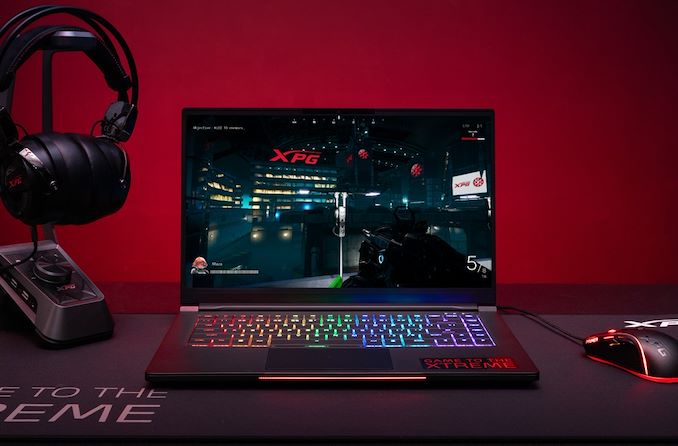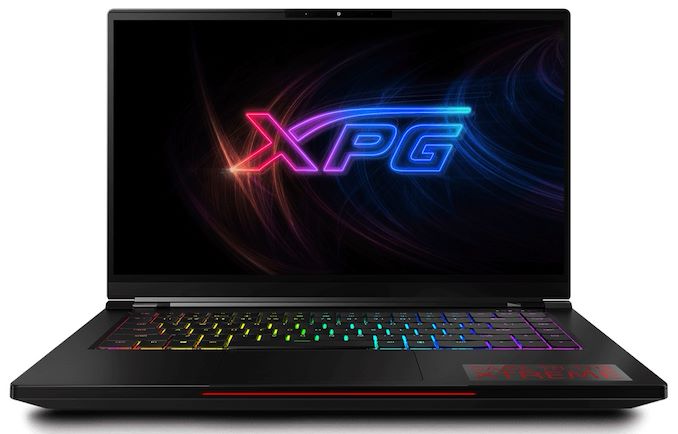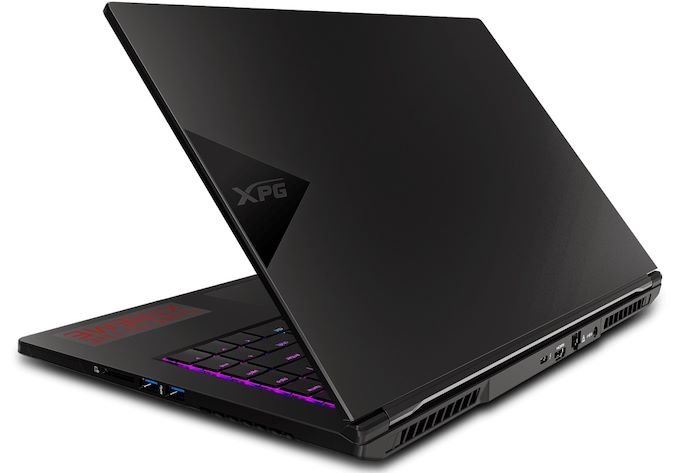XPG Enters the Gaming Notebook Market with the 15.6-inch XENIA
by Gavin Bonshor on April 22, 2020 11:00 AM EST- Posted in
- Laptops
- Intel
- ADATA
- XPG
- XPG SX8200
- RTX 2070
- GTX 1660 Ti
- Comet Lake
- XPG XENIA

XPG, the gaming arm of prolific storage vendor ADATA, has just announced its first-ever gaming notebook, the XENIA. Designed in collaboration with Intel, the 15.6-inch XENIA is based on Intel's 9th Gen Core platform and is paired with NVIDIA's graphics cards. Internally, the laptop uses XPG/ADATA parts throughout, including from XPG's high-performance SX8200 PCIe 3.0 M.2 1 TB SSD, as well as 32 GB of XPG DDR4-2666 SO-DIMM memory. And while XPG is entering a very crowded market for gaming notebooks, the group is none the less looking to make their start a memorable one.
For their first gaming laptop XPG has taken a pretty popular tack, starting things off with a 15.6-inch laptop based on an Intel + NVIDIA platform. And digging deeper, the fact that they're using such a common design is not a mistake: the laptop is based on an Intel white-box design that the tech titan offers to smaller vendors whom need a turnkey laptop design. The XENIA is available in two configurations – changing out the NVIDIA GPU used – with XPG building out a fairly beefy notebook to keep up with the kind of heat that comes from a powerful gaming notebook. And, because it's a gaming notebook, it comes with a 144Hz display as well as RGB keyboard lighting.
Starting at its foundation, the XPG XENIA uses an Intel i7-9750H hex-core Coffee Lake Refresh processor. This isn't exactly a new processor, and it raises some questions about why XPG has not to opted for Comet Lake; none the less Comet Lake didn't move the needle significantly, so the i7-9750H is still plenty capable with a base core clock of 2.6 GHz, with a turbo core clock of up to 4.5 GHz.
The i7-9750H is in turn paired with XPG's own high-end storage and memory parts. On the memory front, all models come with 32 GB of DDR4-2666 memory in SO-DIMM form; and while XPG hasn't gone into details of the memory configuration, 2 x 16 GB DIMM configuration is a safe bet. Meanwhile storage is provided by an XPG SX8200 Pro 1 TB NVMe M.2 SSD, a Silicon Motion SM2262EN-based drive which is rated for read and write speeds of up to 3500/3000 MB respectively.
As previously mentioned, the XPG XENIA includes a 15.6-inch IPS 1080p panel with a 144 Hz maximum refresh rate. Unfortunately the company hasn't published much more about it, so it's not clear what the color gamut and typical performance characteristics are like. Being a gaming-focused laptop, it's likely only capable of covering the sRGB gamut. Also notably absent is any listed support for variable refresh rates.
Driving that high refresh rate display, in turn, are a pair of NVIDIA GeForce GPUs. The base model XENIA comes with a GTX 1660 Ti with 6 GB of VRAM, while the high-end SKU comes with a more powerful GeForce RTX 2070 Max-Q with 8 GB of VRAM.
As for the keyboard, XPG is using silent optical-mechanical switches, with per-key RGB LED backlighting to allow users to customize the design and look of the XENIA. For mouse movement, it has a glass precision click trackpad.
In terms of connectivity, on the wireless front the laptop comes with Intel's latest AX200 wireless adapter, which offers support for Wi-Fi 6 as well as BT 5.0 devices. Meanwhile wired connectivity includes a single Thunderbolt 3 -capable USB Type-C port, and three USB 3.2 G2 Type-A ports. And for display and audio, there's an HDMI port as well as separate headset out and mic in jacks. The laptop even offers Gigabit Ethernet, via an RJ45 port on the back of the machine.
Overall, the XENIA is not the lightest and most portable of 15-inch gaming notebooks on the market; even with magnesium alloy frame, you're looking at a weight of up to 1.85 kg, contained in a laptop 356.4 x 233.6 x 20.5 mm in size. However XPG does put that space to good use, including a 6-cell 94 Wh battery; so while this isn't going to be a laptop that is going to be gaming all day on a battery, it comes with about as much power as a laptop can legally contain. For lighter workloads, XPG has rated the laptop to run for up to 10 hours.
| XPG XENIA Gaming Notebook Specifications | ||
| XPG Xenia (RTX) | XPG Xenia (GTX) | |
| CPU | Intel Core i7-9750H (2.6 GHz Base, 4.5 GHz Turbo) | |
| GPU | NVIDIA GeForce RTX 2070 8 GB Max-Q | NVIDIA GeForce GTX 1660 Ti 6 GB |
| Display | 15.6-inch IPS 144 Hz 1080p | |
| Memory | XPG 32 GB DDR4-2666 SO-DIMM | |
| Storage | XPG SX8200 PCIe 3.0 x4 M.2 NVMe 1 TB SSD | |
| Networking | Intel AX200 Wi-Fi 6 /w BT 5.0 | |
| Battery | 6-cell 94 Wh | |
| Ports | 1 x Thunderbolt 3-capable USB Type-C 3 x USB 3.2 G2x1 Type-A 1 x HDMI 1 x Gigabit Ethernet |
|
| Dimensions (WxDxH) | 356.4 x 233.6 x 20.5 mm | |
| Weight | < 1.85 kg | |
| Price (USD) | ~$2199 | ~$1699 |
Rounding out the XENIA is XPG's software, which includes the XPG Prime application. Though still in beta, XPG Prime allows users to select between performance, balanced, and battery-saving power modes. The software can also be used to monitor system information such as current clock speeds and temperature, and even allow users to customize the RGB LEDs within the keyboard.
Wrapping things up, while XPG has not published any official MSRP information for the laptops, a quick look at the first retail listings shows the GTX 1660 Ti model going for $1699, while the RTX 2070 model is showing up at $2199. The laptop is set to be available in the US, Mexico, and Taiwan imminently, while XPG also states that other markets outside of these three countries will see the XENIA hit retail shelves towards Q3.
Related Reading
- Razer Refreshes Blade 15 Series With Intel 10th Gen Comet Lake
- HP Announces ZBook Studio And ZBook Create Notebooks: Targeting The Top
- AMD's Mobile Revival: Redefining the Notebook Business with the Ryzen 9 4900HS (A Review)
- Intel Details 10th Gen Comet Lake-H for 45 W Notebooks: Up to 5.3 GHz*
- HP ENVY Laptop Refresh Adds OLED and RTX For 2020
- ASUS Updates Chromebook Flip Series With Intel 10th Gen Comet Lake
Source: XPG












24 Comments
View All Comments
PeachNCream - Wednesday, April 22, 2020 - link
XPG doesn't have the resources to design their own computer so as Valantar pointed out initially, they're just hocking the same platform a bunch of other little fish are selling with their logo slapped on it instead of some other little company's logo. Product differentiation begins and ends at the brand label.dwade123 - Wednesday, April 22, 2020 - link
Another win for Intel and Nvidia. When will AMD learn that most people outside of their shill-circle don't care about meaningless Cinebench scores.Valantar - Wednesday, April 22, 2020 - link
... this is an Intel-made reference design rebranded by Adata/XPG, as done before by quite a few others. It would be quite odd if it had an AMD APU, no? Also, Ryzen 4000 APUs perform roughly equal to Intel-based laptops with the same GPU in gaming (while consuming significantly less power). Cinebench is absolutely overvalued, which is why you ought to actually look at gaming benchmarks for those laptops before you start typing.Qasar - Wednesday, April 22, 2020 - link
he cant, and wont though, to him, intel is, and always be king, no matter what anything, anybody, or reviews and benchmarks say.yetanotherhuman - Thursday, April 23, 2020 - link
It's painful to watch. I nobody should be that way unless they're actually paid by Intel. Intel is not his friend. AMD is not his friend. Research and buying the best product for your task is your friend.Holliday75 - Thursday, April 23, 2020 - link
That is too much work for the average person.Valantar - Thursday, April 23, 2020 - link
That's what "best laptops for [use case] [season/month] [year]" guides are for. If you are buying a device as pricey as even a cheap laptop the least you can do is skim a few of those.The next step is to read reviews of a couple of the relevant ones to get a better understanding of whether it fits your specific needs. Of course lots of people couldn't identify their needs if asked, which is where qualified and knowledgeable retail staff come in - knowing which questions to ask to arrive at a good recommendation. IMO these steps are a minimum, but at least looking at an overview guide is within the capabilities of absolutely anyone.
yetanotherhuman - Thursday, April 23, 2020 - link
When will people actually read the reviews and realise that AMD is ahead in PURE SINGLE THREAD WORKLOADS when it comes to mobile chips, at LOWER POWER.Gunbuster - Wednesday, April 22, 2020 - link
"memorable one." Memorable is in sending a vector graphic of the XPG logo for the Clevo/Sager factory to stamp the lid of their chunky boi same as 20 others peddling in buy a laptop from the ODM space?Valantar - Wednesday, April 22, 2020 - link
This isn't a Clevo design, nor is it from that other Chinese no-name OEM that seems to be the go-to laptop OEM if you don't want a Clevo design. It's designed and developed by Intel (probably in cooperation with someone like Foxconn, but not Clevo).